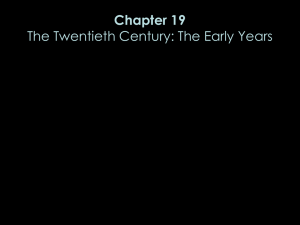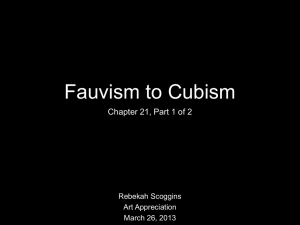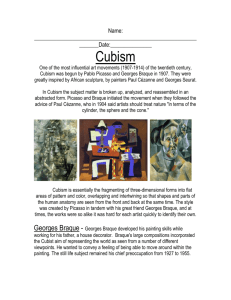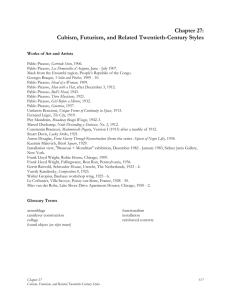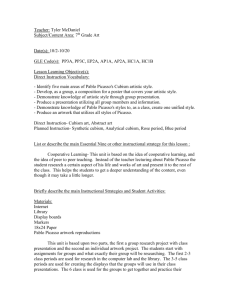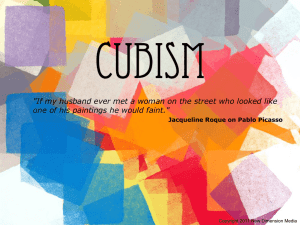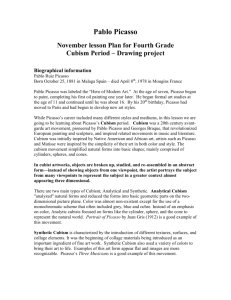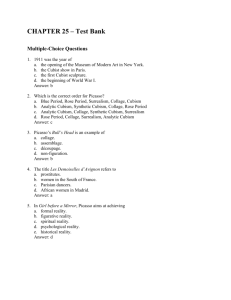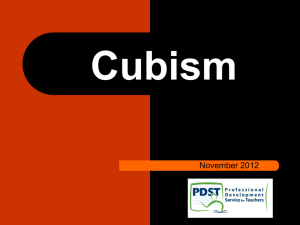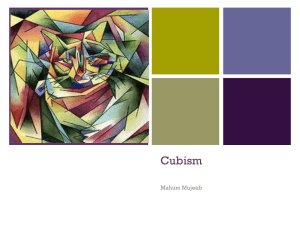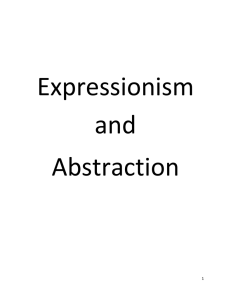Chapter 29
advertisement
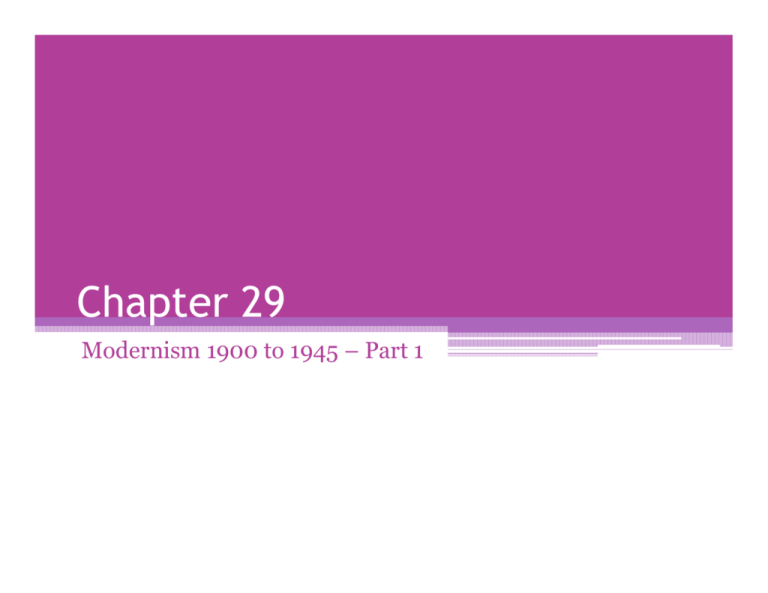
Chapter 29 Modernism 1900 to 1945 – Part 1 The Development of Modernist Art 1900-1940 Key Ideas • Early modern art flourished at a time of immense p political unrest and social upheaval p • Modern artists and architects were quick to embrace new technologies in the creation of their h works k • Avant-garde patrons cultivated cutting-edge artist, ti t allowing ll i them th to t fl flourish. i h • The Armory Show introduced modern art to America and Gallery 291 exhibited photographs America, besides paintings as works of art. • Modern art takes on a more international flavor than ever Vocabulary • Abstract: works of art that may have form, but have little or no attempt at pictorial representation. • Collage: A composition made by pasting together different items onto a flat surface. • Ready-made: y A commonplace p object j selected and exhibited as a work of art. Fauvism ((Wild Beast)) -1905 to 1908 • A movement that debuted in 1905 in the Salon d’Automne in Paris •Named N d ffrom an art critic, i i Louis L i Vauxcelles, V ll thought h h the h paintings looked as if they were created by “Wild Beasts” p by y Post-Impressionist p like Gauguin g and Van •Inspired Gogh that stressed a painterly surface with broad flat areas of violently contrasting color •brilliant brilliant, bold colors •intense color juxtapositions •rich surface textures •lively li l linear li patterns tt Green Stripe, (Madame Matisse) Conventional composition Violent contrast of color Energetic painterly brushwork Exhibited at the 1905 Salon d’Automne in Paris Matisse’s wife Henri Matisse, A Woman with a Hat, 1905 The Joy of Life (Le Joie de vivre) The Open Window Red Room ((Harmonyy in Red), ), Henri Matisse Andre Derain Th Dance The D London Bridge. The Turning Road, L'Estaque Maurice de Vlaminck www.artlex.com/ArtLex/f/fauvism.html artLex www.geocities.com/.../2933/fauves/fvplayers.htm Expressionism p – • Inspired by the Fauve movement • Emphasis on expressing inner feelings • Die Bruke (The Bridge) 1905 – group of German artists in Dresden gathered around Kirchner and saw themselves as a bridge from traditional to modern painting • Der Blue Reiter (The Blue Rider) - formed in Munich in 1911. The group named because of the affection for the color blue. Theyy began g to forsake representation art and more toward abstraction. Highly intellectual, and filled with theories of artistic representation. ▫ A Artist ti t like lik K Kandinsky di k and d march h saw abstraction b t ti as a way of conceiving the natural world ▫ Wassily Kandinsky: credited with painting the 1st “abstract” abstract painting, 1910 German Expressionism: Die Brucke (The Bridge) • • • • • dissonance seeming lack of finesse harsh colors aggressively brushed paint distorted forms Street, Dresden, Ernst Ludwig Kirchner Uncomfortable close encounter with women on a Dresden Street Colors are nonrepresentational, but symbolic and chosen to provide a jarring impact Expressive E i quality lit off horrified h ifi d facial f i l features f t andd grim i surroundings di Titled perspective moves things closer to the picture plane Saint Mary of Egypt among Sinners, Emil Nolde Last Supper Dance Around the Golden Calf Masken II www.avire.ca/.../interpretation.html www.groningermuseum.nl/index.php?id=795 Gardner’s Art Through the Ages German Expressionism: Der Blaue Reiter ((Blue Rider)) • Captured feelings in visual form • expression of innermost feelings by orchestrating color form color, form, line and space • elicits intense response from viewer Small Worlds III Vassily Kandinsky Composition VIII Improvisation 13. •Movement toward abstraction; representational objects suggested rather than depicted •Title derived from musical compositions •Strongly articulated use of black lines •Colors seem to shade around line forms Improvisation 28 Fate of the Animals, Franz Marc The Lamb The Tiger Foxes Woman with Dead Child, Kathe Kollwitz Seated Youth, Wilhelm Lehmbruck C bi Cubism • Born in the studio of Pablo Picasso, who in 1907 revealed the first cubist painting, painting Les Demoiselles d d’Avignon Avignon • characterized by the reduction and fragmentation of natural forms into abstract, often geometric structures usually ll rendered d d as a sett off di discrete t planes. l • Analytical Cubism: 1907-1912 ▫ highly experimental, showing jagged edges and sharp multifaceted l if d li lines • Synthetic Cubism: 1912 ▫ Initially inspired by collages and found objects and featured flattened forms • Curvilinear Cubism: 1930 ▫ More flowing g rounded responses p to the flattened and firm edges of Synthetic Primitivism & Cubism •Breaking up of nature into geometric figures and planes •Leading artists: Pablo Picasso and Georges Braque Braq e • Primitivism = influenced by African Art • Cubism Characteristics: •Distortion •Flattened space •Fragmentation Fragmentation •Restricted palette •Grid/scaffold – black lines Cubism: Definition • “The art of painting original arrangements composed of elements taken from conceived rather than perceived reality.” ▫ --Guillaume Guillaume Apollinaire, The Beginnings of Cubism, 1912 Les Demoiselles d’Avignon, Pablo Picasso Mbuya Mask •1st Cubist work, influence by late Cezanne, and African masks •Represents five prostitutes in a bordello on Avignon Street in Barcelona, each posing for a customer •Poses are not traditionally alluring but awkward, expressionless, and uninviting •No real depth •Three on left more conservatively painted, two on right more radical; reflects a dichotomy in Picasso •Multiple views expressed at the same time Influenced by African masks Gertrude Stein Pablo Picasso http://www.public.asu.edu/~usman/images/images-Africa/Ifebronze-mask.jpg www.cartage.org.lb/.../AfricanTribalArt2.htm Analytic Cubism •separating and analyzing various forms forms. •extreme flattening of space, as well as violent shattering of the subject and use of multiple perspectives painted Georges Braque The Portugese Champs de Mars or The Red Tower Robert Delaunay Homage to Bleriot The City of Paris Sun, Tower, Aeroplane Eifel Tower www.artinthepicture.com/paintings/view.php?nr=374 www.paletaworld.org/artist.asp?id=2616 S th ti C Synthetic Cubism bi •more more ornamental and the colors used played an important role •glued objects such as paper and cloth to canvas ( ll ) (collage) Pablo b o Picasso c sso Still Life with Chair-Caning, "Still Life with bowl and Fruit" Fruit Glass and Bottle of Suze (1912) Georges Braque Bottle, Newspaper, Pipe and Glass Glass, Carafe Gl C f and Newspapers Pablo Picasso, Guernica, 1937 •Painted for the Spanish pavilion of the 1937 Parisian World’s Fair •A reaction to the Fascist bombing of the militarily insignificant town of Guernica in northern Spain during the Spanish Civil War •Done in black and white to imitate news photos •Picasso usually not a symbolic painter but many symbols •Pieta on left with stigmata on child’s hands •Bull symbolized brutality and darkness; but could also symbolize Spain herself •Fallen warrior at bottom left holds a broken sword, perhaps meant to evoke a fallen war memorial •Woman with torch is an allegory of Liberty •Horse in panic tramples on everything and everyone •Wounded figures on right rush in, seeking shelter •Figures in perspective on bottom recall the dead figures in Uccello's Battle of San Romano Maquette for Guitar Pablo Picasso Jacques Lipchitz Guitar Player in A Armchair, h i Seated Man with Clarinet Head Sculpture Bather Woman Combing Her Hair Aleksandr Archipenko Woman Combing Her Hair Julio Gon ale Gonzalez Purism •Le Corbusier was one of the most important modernist architects but he was also a painter. He founded a movement that was opposed to Synthetic Cubism on the grounds it was decorative art and out of touch with the machine age. Purists maintained machinery machinery’ss clean functional lines and •Purists the pure forms of its parts should direct artist’ experiments in design, painting, and architecture. •Uses machinery’s lines lines, forms combined with Cubism analysis of form Table and Fruit, Fernand Leger The City Woman with a Cat, www.artlex.com/ArtLex/c/cubism.html The Wedding, 1911 Futurism •Just before WWI, WWI a group of Italian artist came together to celebrate the scientific and technological progress of the modern world. The glory of the machine and a fascination with speed - political movement •Outgrowth of Cubism •Sought Sought to capture motion & the “beauty beauty of speed speed”,, (relate to pictures like Muybridge’s that showed movement) •Championed by Poet Filippo Marinetti in the “The Futurist Manifesto” •simultaneity of views Giacomo Balla Dynamism of a Dog on a Leash The Hand of the Violinist, Speed of a Motorcycle Flight of the Swallows •The Futurists’ interest in motion and the Cubists dissection of form •Achieved the effect of motion by repeating shapes such as the dog’s legs and tail and swinging line of the leash •Affected by the atmosphere around it as it strides pridefully forward •Provides the illusion of movement •Abstract forms fly around the armless figure •Has a curious resemblance to the Nike of Samothrace, the ancient sculptor suggested motion only th through h posture t andd agitated it t d drapery d www.artinthepicture.com/.../view.php?nr=2319 Umberto Boccioni, Unique Forms of Continuity in Space Armored Train Gino Severini Red Cross Train Passing a Village Dada a nonsense word that means “hobby horse” •Western Europe: artistic, literary movement from 1916 to 1923 •Disillusioned by the useless slaughter of WWI, they rejected conventional methods of representation and conventional manner in which they were exhibited. It was an “anti-art” movement, political anarchy, irrational, intuitive •Oil Oil and canvas can as were ere abandoned abandoned. •The Dadaists accepted “ready-mades” as an art form and did many of their works on glass •state of mind, not identifiable style •element of absurdity, whimsical, humor disdain for convention or tradition •disdain •nothing taken seriously Collage Arranged According to the Laws of Chance Jean (Hans) Arp •In I this hi collage, ll Arp A dropped torn paper and then glued them where they fell. •His reliance on chance in composing this work was part of the Dada movement Bicycle Wheel Ready-made Marcel Duchamp, Fountain, second version,1 950 •Ready-made sculpture, actually a found object that deemed to be a work of art •Entered in an unjuried show, but the work was refused •Signed by the “artist” R. Mutt, a pun on the Mutt and Jeff comic strip and Mott Iron Works •Title Fountain a pun; fountains spout liquid a urinal is meant to collect it liquid, The Bride Stripped Bare by Her Bachelors Marcel ce Duchamp uc p •Playful and serious examination of humans as machines •The bride is a motor fueled by “love gasoline” •The bachelors appear as uniformed if d male l figures fi in i the th lower half of the composition •During the transportation of an exhibition in 1927,, the glass broke. Duchamp painstaking pieced together the glass fragments. He declared the work completed “by chance.”



